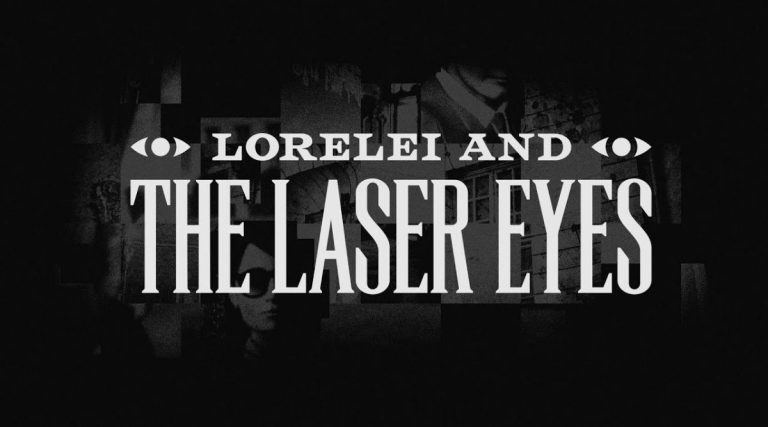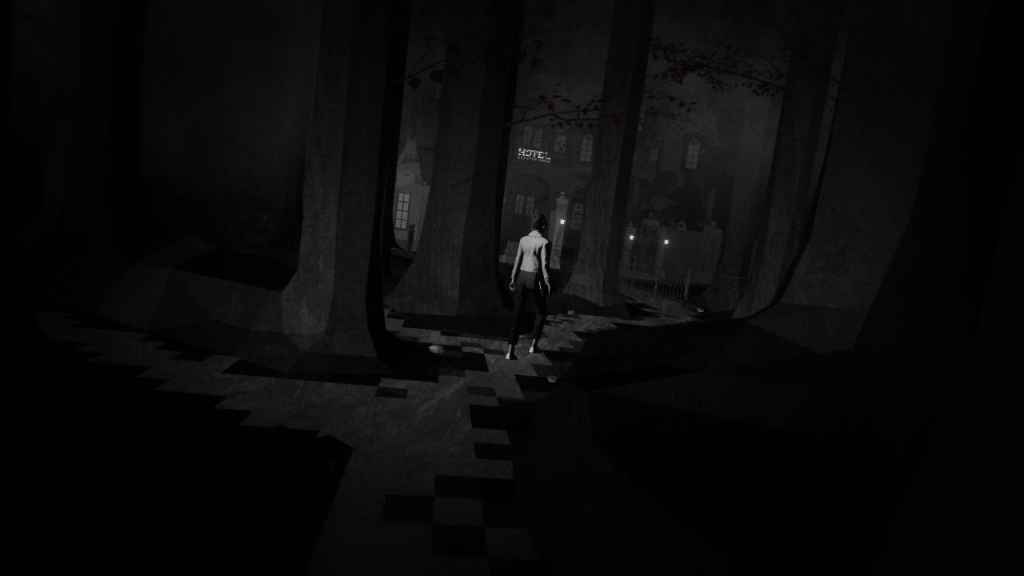Lorelei and the Laser Eyes PS5 Review. Writing a review for Lorelei and the Laser Eyes is a unique challenge in of itself thanks to how singular this game is in everything it sets out to achieve. The foundation of a fixed camera angle survival horror is used in the context of a twisting and turning puzzle game that challenges every convention that we’ve come to expect of the genre.
In sharp contrast to Sayonara Wild Hearts, Simogo’s work in Lorelei and the Laser Eyes is daring, adventurous and downright strange in ways that kept me guessing as I wound my way through the fragmented corridors of this lost hotel.
Lorelei and the Laser Eyes Review (PS5) – Pushing To The Limits
A Layered Experience
The developers of Lorelei and the Laser Eyes have been candid in their intentions with this game, proudly asking players to keep a pen and paper at their side as they make their way through the eight-hour or so adventure in order to enhance their experience. While I initially rolled my eyes at the suggestion of taking notes for a game like this, I quickly relented and cracked out the notebook to keep tabs on all kinds of information that I thought could be relevant.
Before I knew what I was doing, I was deftly observing environmental details and jotting them down for later. The layout of statues, where I’ve been, replicating important symbols, I was going through page after page of paper as I tried to pay attention to every minute detail. I’d actually put a sample of one of my pages here, but that’d do the disservice of spoiling some of the conundrums at the beating heart of this game.
I was initially expecting a more “traditional” survival horror experience with the visual style and movement around the world, but was pleasantly surprised that I was left to explore at my own pace without the oppressive presence of a nemesis-style threat following me around for the majority of the time. You’re thrown into the halls of the hotel and left to explore where you like, as you like.
Making Sense out of Madness
That isn’t to say that you’re given no direction as to what to actually do in the hotel or why you’re there. The game abruptly opens with an unnamed woman in the forest, with vague instructions to meet a mystery man. After doing so, you’re forced to solve puzzles and navigate vague notions of dialogue and confusing premises as you uncover the truth of why you’re there.
There’s a focus on the abstract here and it’s a dimension that I feel is explored incredibly well and without feeling too heady or hard to parse for someone new to these ideas. Despite how much of the game depends on your own initiative in solving puzzles, it never felt obtuse or needlessly convoluted in how you reach solutions. You just need to pay attention and it’ll come naturally to you.
This speaks to the sheer quality of the puzzles on offer here. Despite the weird concepts at play, I felt like I was being nudged just enough to make important leaps of logic and feel satisfied without the need for a guide. You’re invited to explore and toy with your surroundings and I found that refreshing in an era where it feels more and more that environments are set-dressings for narratives. You form the narrative here as you solve the mystery of this weird building.
Quite literally – the game logs automatically the last major thing that you did in a constantly updating timeline. I found this feature to be incredibly useful after taking a break and having to reorient myself and what I was trying to solve.
My one reservation – and I admit that this is incredibly personal – is that a good deal of the optional puzzles in this game aren’t necessarily baked into the experience that well. Early on, you gain access to a puzzle book full of pretty rudimentary puzzles that don’t feel like they exist in the same league as the main ones. Where the environmental puzzles challenge you to draw on information that you’ve discovered in interesting ways, I spent a decent amount of time just working out the orientation of dice and pretty simple number riddles.
I found that these puzzles didn’t fold back into the main experience as well as everything else and that they dented pacing in places. Then again, those with a penchant for maths problems might find these to be an involved way of impacting the world. Shortcuts aren’t a required part of exploration, but this extra layer does mean you have to actually engage with them to gain an advantage.
A Muted Palette
One of the most striking aspects of Lorelei and the Laser Eyes is the incredibly selective use of colour throughout, and the way that it’s used to direct player attention. The vast majority of the environments that you explore exist in a timeless space dominated by a monochromatic colour scheme that serves the eerie ambience incredibly well. There’s uncertainty as you explore the hotel and this is aided by an unconventional colour scheme.
The inherent benefit of having this kind of approach to visual design is the ability to naturally draw attention to key areas without intrusive UI elements. Lorelei and the Laser Eyes is an incredibly clean game, with UI being baked into the experience rather than being imposed on the player’s perspective and ripping them out of the illusion. Subtle arrows are pointed on the floor that helpfully highlight doorways, and splotches of coloured paint lead you in key directions for progression or areas to explore.
As well as being great visual indicators, these also lend intrigue to the story at hand. What are the magenta paint splotches around the house? Why does the mystery man leave coloured footprints? Is it actually paint? These are some of the questions that I had early on and that’s only the tip of the proverbial iceberg. I came to learn the eccentric layout of the game’s various areas like a classic Resident Evil game, and that was a benefit for more reasons than one – but that would be telling.
Despite having a very selective use of colour, the game goes as far as it logically can and some moments were genuinely breathtaking as I saw the routes they took with imaginative framing and exploration. A modest beginning gives way to a game that felt wholly unique yet totally cohesive and without overextending its own reach.
My one reservation is that I did sometimes find that interacting with the environment could be a bit cumbersome at points. There are no real “controls” in the traditional sense, with all important aspects of the game being locked to movement or simple contextual button presses. When you’re not next to an object of interest, you open a screen where you can review every piece of information that you’ve come across so far. Incredibly useful for puzzles, but less useful when I’m trying to muddle around an area. It was even less useful when there wasn’t a button to quickly back out of the menu. This simple decision took some getting used to but was a shocker to my muscle memory.
Just remember, the circle button isn’t for walking back your menu choices.
This was ultimately a very small matter of getting used to a different control scheme, and I’m glad this was in a game that didn’t particularly demand the world from me in terms of physical coordination or planning.
Extending an Invite
There’s an interplay between the player and the world of the game that I’m excited to have experienced, but reluctant to share in this review. I was consistently surprised with how the 4th wall was broken, and mechanics recontextualised to make sense within the framework of Lorelei and the Laser Eyes. One of the least spoilery examples I can give is related to the save system of the game itself; there’s no autosave function in Lorelei and the Laser Eyes, you’re invited to be very deliberate with your exploration and saving.
Done through a diegetic computer system, I was surprised by how layered this (now standard) convention became, in ways that won’t be touched upon here for fear of giving anything else away.
The lines between reality and fiction are constantly twisted and blurred in ways that had me glued to the screen into the early hours of the morning. I became obsessed with discovering the truth of the story here, with just enough breadcrumbs to lead me to the end.
That’s the main issue with writing about Lorelei and the Laser Eyes – I had the privilege of going in almost totally blind and I would implore you to do the same if you can. Despite what sounds like a high barrier to entry, I found a compelling puzzler that honestly changed the ways that I think about playing games and environmental design.
Most importantly, Lorelei and the Laser Eyes embraces itself as an interactive story. For how successful the triple-A cinematic space can be, it often feels like these experiences are catering to a crowd that are unsure of video games as an inherent vehicle for stories. From the fact that there’s an actual in-universe manual for a game called Lorelei and the Laser Eyes, to the inventive use of classic mechanics, this is a story that can only exist in the form of a game and will be a shining example of just what this medium can do.





